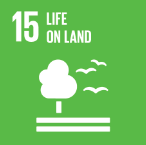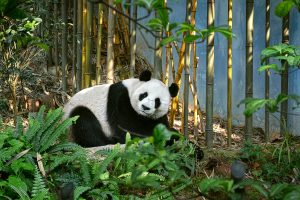SDG15 – Life on Land

New Vocabulary
- nature
- desertification
- disappearing
- deforestation
- destroy
- wildlife
- rural
- species
- extinction
- habitat
Practice the new vocabulary
Life on Land Vocabulary Practice (text version)
Match the words to their definitions:
Words
- habitat
- extinction
- nature
- species
- disappearing
- desertification
- destroy
- wildlife
- deforestation
- rural
Definitions
- everything that has to do with the earth, including plants, animals, and weather
- the act of regular land changing into a desert
- can no longer see
- the cutting down of all trees in an area
- to damage so badly that it cannot be recovered
- animals and plants in nature
- country area
- a certain type of plant or animal
- the act of a certain animal or plant no longer being around
- place where animals or plants live
Check your answer in footnote[1]
Activity source: Life on Land Vocabulary Practice by Virginia McHardy, CC BY-NC 4.0
Life on Land
According to the United Nations Department of Economic and Social Affairs (n.d.) Goal 15 Infographic:
Goal 15 is about protecting nature and making sure we use land in a sustainable way. This includes taking care of forests, stopping land from becoming dry and unusable (desertification), and preventing animals and plants from disappearing (biodiversity loss).
Forests cover about 31% of the Earth and are home to 80% of land animals and plants. However, forests are being cut down too quickly, mostly for farming. 90% of deforestation happens because of agriculture, and this destroys homes for wildlife and increases climate change.
When forests disappear, it affects people’s lives, especially in rural areas. It also increases carbon in the air, leading to more climate problems. Right now, one million species are in danger of extinction because of human activities.
Losing nature can also harm our health. When we destroy habitats, diseases from animals (like COVID-19) can spread more easily to humans. Every year, 2 million people die from diseases that come from animals, especially in poorer countries.
Canadian Perspective
Goal 15, Life on Land (text version)
Protect, restore and promote sustainable use of terrestrial ecosystems, sustainably manage forests, combat desertification, and halt and reverse land degradation and halt biodiversity loss
Forest Area
Between 2015 and 2021, forest area has remained stable covering nearly 40% of Canada’s land area. Over 75% of Canada’s forests lie in the boreal zone covering over 280 million hectares.
Conserved Terrestrial Areas
At the end of 2022, 13.6% of Canada’s terrestrial area was conserved[2], progressing towards the 2025 target of 25%. Between 2015 and 2022, terrestrial area conserved increased 33%.
Wild Species
In 2020, 80% of native wild species[3] were ranked as secure or apparently secure,[4] unchanged from 2015. Among species, 84% of insects, 80% of vertebrates and 27% of corals were ranked as secure or apparently secure.
Community Spotlight: Nature Canada
Nature Canada is an environmental charity that has been working to protect nature and wildlife in Canada for 80 years by engaging grassroots partner organizations and nature-lovers to help Canadians discover, defend and restore nature.
Since 2020: 40,000+ youth connected to nearby nature; 1,200+ nature organizations helping nature in their communities; and 300,000+ letters to decision-makers from nature-lovers across Canada.
Sources: Natural Resources Canada, The State of Canada’s Forests, 2022. Environment and Climate change Canada, Canadian Environmental Sustainability Indicators, Wild Species 2020: The General Status of Species in Canada. Environment and Climate Change Canada, Canadian Environmental Sustainability Indicators, Canada’s Conserved Areas. Nature Canada, 2023.
Source: Goal 15, Life on Land In Agenda 2030 Sustainable Development Goals Report, 2022 by Statistics Canada, used under Open License
Discussion Questions
Use the new vocabulary words in these discussion questions. Ask and answer in partners or small groups:
- What do you enjoy most about nature? How can we take better care of it?
- When land becomes dry and unusable, it is called desertification. What do you think causes this problem? How can people prevent it?
- Many forests and animals are disappearing. Why do you think this is happening? What are the effects?
- Cutting down too many trees (deforestation) is a big problem. Why do people cut down forests? What are some solutions?
- What are some human activities that destroy the environment? What can we do to stop this?
- What kinds of wildlife are found in your country? Why is it important to protect animals and plants?
- People in rural areas often depend on nature for their jobs and food. How does environmental damage affect rural communities?
- Some species of animals and plants are in danger. Can you name any endangered species? What can be done to protect them?
- When a species goes extinct, it disappears forever. Why is extinction a serious problem? How can we prevent more animals from going extinct?
- Animals need safe places to live, called habitats. What happens when a habitat is destroyed? How can we help protect animal habitats?
Watch the video:
Watch Goal 15 – Life on Land (2 mins) on YouTube
Video source: UNStats. (2022, July 7). Goal 15 – Life on land [Video]. YouTube. https://www.youtube.com/watch?v=v0DK06GzpJg
Life on Land video quiz (text version)
- True or false? The use of new and modern machinery helps the earth so that more crops can be farmed.
- Why are most forests around the world destroyed?
- To build houses and create large neighbourhoods.
- To give lumberjacks jobs.
- To create more farms and grow crops.
- Complete the sentence using the words provided:
Words: disappear, types
Sentence: In the next several years, about 40,000 [Blank A] of animals are likely going to [Blank B]. - True or false? There has been a lot of funding to stop the extinction of endangered animals after the global pandemic.
- What are the 3 areas that are protected?
- sea water, forests, and mountains
- fresh water, the earth and deserts
- fresh water, the earth and mountains
- Complete the sentences below using the words provided:
Words: benefits, natural resources, respectfully, medicine, permission
Sentences: The Nagoya Protocol is a rule about sharing [Blank A] in a fair way. It helps make sure that when people use plants, animals, or other natural materials for [Blank B], food, or science, they do it fairly and [Blank C]. This means that if a company or scientist takes a plant from one country to make a new medicine, they should ask [Blank D] and share the [Blank E] with the people from that country.
Check your answer in footnote[5]
Activity source: Life on Land Video Quiz by Virginia McHardy, CC BY-NC 4.0
Key Targets for SDG 15
- 15.1 By 2020, ensure the conservation, restoration and sustainable use of terrestrial and inland freshwater ecosystems and their services, in particular forests, wetlands, mountains and drylands, in line with obligations under international agreements.
-
15.2 By 2020, promote the implementation of sustainable management of all types of forests, halt deforestation, restore degraded forests and substantially increase afforestation and reforestation globally.
-
15.3 By 2030, combat desertification, restore degraded land and soil, including land affected by desertification, drought and floods, and strive to achieve a land degradation-neutral world.
-
15.4 By 2030, ensure the conservation of mountain ecosystems, including their biodiversity, in order to enhance their capacity to provide benefits that are essential for sustainable development.
-
15.5 Take urgent and significant action to reduce the degradation of natural habitats, halt the loss of biodiversity and, by 2020, protect and prevent the extinction of threatened species.
-
15.6 Promote fair and equitable sharing of the benefits arising from the utilization of genetic resources and promote appropriate access to such resources, as internationally agreed.
-
15.7 Take urgent action to end poaching and trafficking of protected species of flora and fauna and address both demand and supply of illegal wildlife products.
-
15.8 By 2020, introduce measures to prevent the introduction and significantly reduce the impact of invasive alien species on land and water ecosystems and control or eradicate the priority species.
-
15.9 By 2020, integrate ecosystem and biodiversity values into national and local planning, development processes, poverty reduction strategies and accounts.
-
15.a Mobilize and significantly increase financial resources from all sources to conserve and sustainably use biodiversity and ecosystems.
-
15.b Mobilize significant resources from all sources and at all levels to finance sustainable forest management and provide adequate incentives to developing countries to advance such management, including for conservation and reforestation.
-
15.c Enhance global support for efforts to combat poaching and trafficking of protected species, including by increasing the capacity of local communities to pursue sustainable livelihood opportunities.
-
Source: United Nations Department of Economic and Social Affairs. (n.d.). Goal 15 [Infographic]. Sustainable Development Goals. https://sdgs.un.org/goals/goal15

Homework/Assignment
- Write a paragraph answering the following question – If you could save one endangered animal, which one would you choose and why?
- Take a walk in a park, forest, or rural area. Observe plants, animals, and how people interact with nature:
- Write about three things you see in nature (trees, animals, insects, rivers, etc.).
- Describe any problems you notice (litter, tree cutting, pollution, etc.).
- Suggest one way to protect this environment.
Reflection Question: How did this walk change your thoughts about nature?
- Plant a small tree, flower, or vegetable at home or in your community.
- Take a photo or draw a picture of your plant.
- Write a short journal about your experience: What did you plant? How does it help the environment?
- Share with the class in a short presentation or discussion.Reflection Question: How can planting trees help fight deforestation?
You can read more about Goal #15 in The Sustainable Development Goals Report 2022 from the UN.:
For instructors, please visit York University’s The SDGs-in-the-Classroom Toolkit for lesson ideas
Attribution & References
Except where otherwise noted, this page is created by Virginia McHardy, CC BY-NC 4.0
References
United Nations Department of Economic and Social Affairs. (n.d.). Goal 15 [Infographic]. Sustainable Development Goals. https://sdgs.un.org/goals/goal15
- 1. nature, 2. desertification, 3. disappearing, 4. deforestation, 5. destroy, 6. wildlife, 7. rural, 8. species, 9. extinction, 10. habitat ↵
- Terrestrial area includes both land and freshwater area. Conserved areas are lands and waters where human use is limited. They include protected areas as well as other effective area-based conservation measures. ↵
- Wild species excludes viruses and bacteria. ↵
- Includes only species that have a NatureServe numerical rank (secure to critically imperiled). ↵
- 1. True. 2. c. 3. a) types, b) disappear. 4. False. 5. c. 6. a) natural resources, b) medicine, c) respectfully, d) permission, e) benefits ↵
everything that has to do with the earth, including plants, animals, and weather
the act of regular land changing into a desert
can no longer see
the cutting down of all trees in an area
to damage so badly that it cannot be recovered
animals and plants in nature
country area
a certain type of plant or animal
the act of a certain animal or plant no longer being around
place where animals or plants live
the act of a certain animal or plant no longer being around

